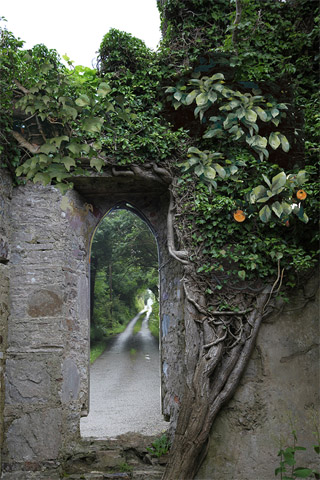Wendy Seller: Visual Metaphors, New Paintings
Wendy Seller, Fictitious Portal, 2013
by Alicia Faxon
WENDY SELLER: VISUAL METAPHORS, NEW PAINTINGS
Bannister Gallery, Rhode Island College . Providence, RI ric.edu/bannister
January 23-February 19, 2014
Wendy Seller is a painter of fragments, digitally realized. Her reconstituted landscapes and imaginary portraits draw on paintings and photographs as well as her own paintings, combined in evocative and mysterious ways.
Originally a neo-surrealist painter, she connects new techniques to capture an invented world, unsettling and imaginative in nature. Her landscapes are taken from different areas in Ireland, a landscape she has documented in recent years. Her portraits echo mainly Renaissance prototypes, reinterpreted. She takes the viewer on a journey whose itinerary and monuments are both real and imagined. Seller’s technique underscores her embrace of a unique domain occupied by particular representations.
The exhibition commences with Untitled (Portal) in which the viewer is confronted with a weathered entryway surmounted by a contemporary arch, and embellished with leaves taken from a Burne-Jones painting. It speaks of time and mortality and the forces of life breaking through. In another doorway painting, Childhood Reflections, the artist captures the receding perspective of a Renaissance palace, garnished with leaves and flowers. Mysterious figures on the left peer into the space, adding an unexpected atmosphere to the image.
The Renaissance motif continues in Fractured Soul, showing a woman in an elaborate period gown, startlingly lacking the top of her head. She looks out in a troubled way, hands anxiously intertwined. Angelic Girl is a colorful figure holding a lily, possibly a harbinger of the Annunciation. In this work Seller has been able to show the head both in three-quarter face and profile, seemingly speaking yet silent, worldly and unworldly.
Ireland’s plight is recalled in Untitled (Ballyvaughan) which shows a deserted house, roof falling in, perhaps recording the terrible potato famine and emigration of so many Irish people in the 19th century, whose houses remain empty and in ruin. In front of this derelict house painted foliage abounds, evidence again of joining together the living with the dead.
Seller is a painter of the liminal, offering access to worlds present and past. She upsets our expectations and challenges our perceptions in traditional and digital methods and configurations
—Alicia Faxon
Alicia Faxon is an art historian, writer and art critic and professor emerita of Simmons College, Boston. She has written for Art New England for a number of years.

